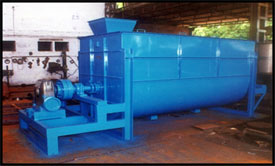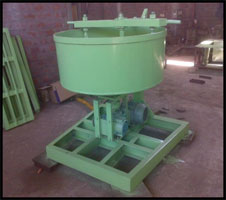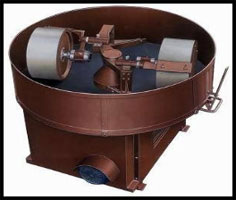Mixing Equipments |
Ribbon Blender |
Ribbon Blender comprises of a U-shaped horizontal trough and a specially designed Double Helical Ribbon Agitator rotating within. Ribbon Blenders are based on a proven agitator construction that provides a triple mixing action ensuring fast efficient blending. The dimensions and configuration of the ribbons are carefully balanced to provide a movement of material within the container that avoids dead spots and gives rapid product discharge. |
The outer ribbon displaces the material from the ends to the center while the inner ribbon moves the material from the center to the ends. This counter-current action results in homogenous blending. |
| |
 |
Features and Benefits
|
- Simple structure and easy to maintenance
- Long service life
|
|
Pan Mixture |
We offer an extensive range of Pan Mixers with outputs from 400 liters to 3,300 liters. This makes them suited to a wide range of users, from small builders to ready-mix plants. Pan Mixers are ideal for mixing mortar and wet and dry screeds. All Pan Mixers in our range can be fed via a variety of methods including a bucket rail system or conventional conveyor belt and radial scrapers. Larger models are fitted with dual mixing sequence and double rotation mixing arm giving a fully homogenized mix within 60 seconds. |
| |
 |
Features and Benefits
|
- Efficient Mixture
- High material handling capacity
|
|
Muller Mixture |
The Muller type mixer provides additional mixing forces over that of more conventional mixers to assure that the total mixture prepared is of uniform consistency. Unlike conventional mixing, mulling provides forces that incorporate kneading, shearing, smearing, and blending of materials for total uniform consistency. This process produces just enough pressure to move, intermingle and push particles into place without crushing, grinding, or distorting the ingredients. The result is a final mixture of truly uniform consistency in both physical and chemical structure. |
Mulling is an extension of mixing resulting from the intensification of work forces the work forces are applied via the tread of weighted mulling wheels. The weight, and thereby the mixing efficiency, is controlled through a spring suspension arrangement on the wheel that is fully adjustable and allows the user to increase or decrease the amount of work that is applied to the mixture via the mulling wheel. |
| |
 |
Features and Benefits
|
- less expensive and easier to use initially
|
|



